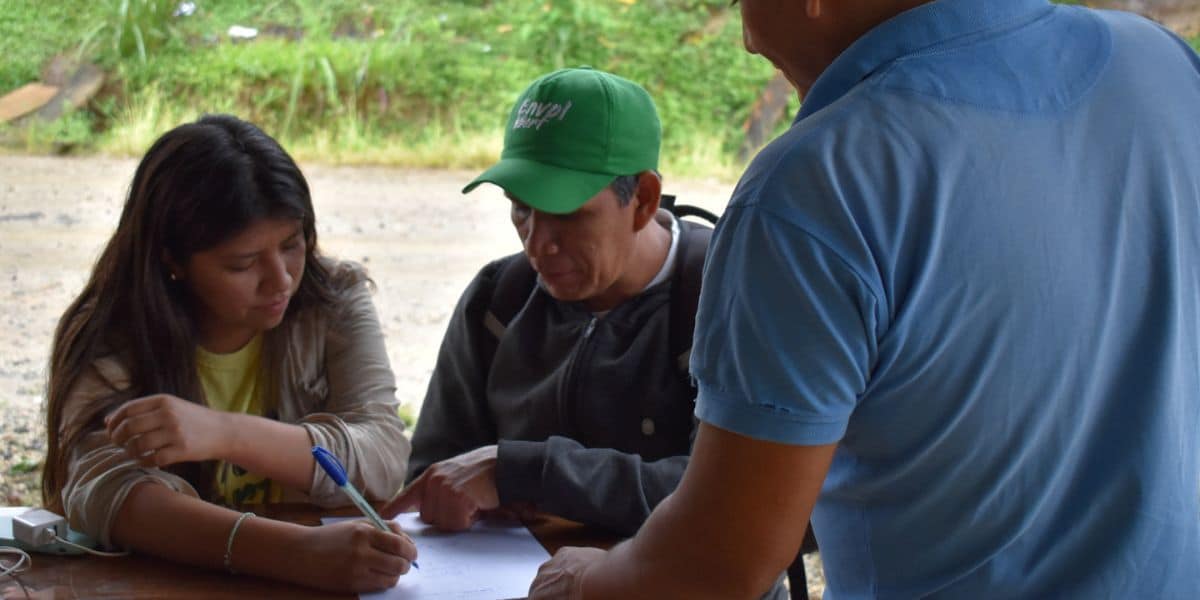Since the beginning of January 2024, the Envol Vert Pichanaki team has been visiting villages in the buffer zone of the Pui Pui Protected Forest, thanks to our partner, the National Service for State Protected Natural Areas (SERNANP), which provided us the contacts to work with the villages in which they carry out various activities. In March, diagnostic visits were made to the parcels of land belonging to groups of inhabitants of Nueva Florida, Ayte and la Florida del Río Ayte.

The farmers accompanied the Envol Vert team
to carry out a diagnosis of their parcels © Envol Vert
High potential for forest conservation in the buffer zone
The aim of these visits is to evaluate the interest of local groups in working with Envol Vert on actions to conserve the forest and develop economic alternatives. There is great potential for conservation in the buffer zone, but there are also many threats, such as the presence of a road. A road facilitates access to new land, encouraging the creation of new farms, at the risk of generating deforestation.
The Envol Vert team visited a total of 6 parcels belonging to different farmers who were very interested in conserving their forests. Some farmers have waterfalls on their parcels, as in the case of Timoteo, a farmer from the village of Nueva Florida.
The richness of local biodiversity
During these visits, we were able to corroborate with farmers the presence of Tremarctos ornatus (spectacled bear), Rupicola peruvianus (andean cock-of-the-rock), Psarocolius decumanus (crested oropendola), Ateles belzebuth (The white-bellied spider monkey), among other species.

Some of the animal species found in the buffer zone of the Pui Pui protected forest
In addition, tree species such as Ulcumano, Virgin Cedar, Moena Rosada and Tornillo were found in their wooded areas, with great potential for nurseries. Some farmers have also told us that they have black walnut trees on their parcels – a great opportunity to open up this area and ensure that the work carried out is even more focused on forest conservation !
The Pichanaki team will continue to carry out diagnostics in these villages to identify nurseries, black walnut trees and explore the potential for implementing ecotourism, which some participants have already begun to do. This will enable us to start conservation activities in the buffer zone, in collaboration with our partner SERNANP.
Since the beginning of January 2024, the Envol Vert Pichanaki team has been visiting villages in the buffer zone of the Pui Pui Protected Forest, thanks to our partner, the National Service for State Protected Natural Areas (SERNANP), which provided us the contacts to work with the villages in which they carry out various activities. In March, diagnostic visits were made to the parcels of land belonging to groups of inhabitants of Nueva Florida, Ayte and la Florida del Río Ayte.

The farmers accompanied the Envol Vert team
to carry out a diagnosis of their parcels © Envol Vert
High potential for forest conservation in the buffer zone
The aim of these visits is to evaluate the interest of local groups in working with Envol Vert on actions to conserve the forest and develop economic alternatives. There is great potential for conservation in the buffer zone, but there are also many threats, such as the presence of a road. A road facilitates access to new land, encouraging the creation of new farms, at the risk of generating deforestation.
The Envol Vert team visited a total of 6 parcels belonging to different farmers who were very interested in conserving their forests. Some farmers have waterfalls on their parcels, as in the case of Timoteo, a farmer from the village of Nueva Florida.
The richness of local biodiversity
During these visits, we were able to corroborate with farmers the presence of Tremarctos ornatus (spectacled bear), Rupicola peruvianus (andean cock-of-the-rock), Psarocolius decumanus (crested oropendola), Ateles belzebuth (The white-bellied spider monkey), among other species.

Some of the animal species found in the buffer zone of the Pui Pui protected forest
In addition, tree species such as Ulcumano, Virgin Cedar, Moena Rosada and Tornillo were found in their wooded areas, with great potential for nurseries. Some farmers have also told us that they have black walnut trees on their parcels – a great opportunity to open up this area and ensure that the work carried out is even more focused on forest conservation !
The Pichanaki team will continue to carry out diagnostics in these villages to identify nurseries, black walnut trees and explore the potential for implementing ecotourism, which some participants have already begun to do. This will enable us to start conservation activities in the buffer zone, in collaboration with our partner SERNANP.






